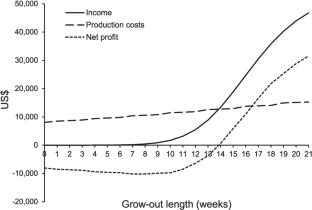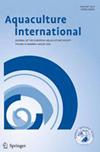Alfredo Hernández-Llamas, Magda E. Domínguez-Machín, Álvaro Hernández-Flores, Miguel A. Vela-Magaña
求助PDF
{"title":"水产养殖投资项目优化设计的随机生物经济方法——以墨西哥尤卡坦东部牡蛎养殖密度、轮作时间和生产规模为例","authors":"Alfredo Hernández-Llamas, Magda E. Domínguez-Machín, Álvaro Hernández-Flores, Miguel A. Vela-Magaña","doi":"10.1007/s10499-025-02231-1","DOIUrl":null,"url":null,"abstract":"<div><p>A stochastic bioeconomic approach is introduced to optimize the design of aquaculture investment projects. Eastern oyster (<i>Crassostrea virginica</i>) farming in Yucatan, Mexico, serves as a case study using stocking density, rotation time, and production scale as decision variables for design optimization. The results from the Monte Carlo simulation and an optimization algorithm revealed that the maximum mean internal rate of return (IRR) and net present value (NPV) were 29.8% and US$69,947.63, respectively, and the optimum design was obtained by covering 78% of the area of rearing gear (NESTIER©-type trays), 21-week rotation time (2.5 crops/year), and planting 426,000 juveniles. A pilot project was projected for a production scale of 338,000 planted juveniles, where a minimum attraction rate of return (13.15%) is expected. The mean net profit over production costs was US$31,543.47 under the optimum scenario, requiring the production of 23,300 dozen oysters. Considering the optimal rotation time, the total annual net profit and production are US$78,858.6 and 58,250 dozen, respectively. The sensitivity analyses revealed that oyster prices and the recruitment process to oyster commercial populations primarily affected net profit, whereas stocking density and production scale had similar effects on the IRR. Optimizing the design of an aquaculture project is a complex problem involving careful balancing of multiple biological, operational, and economic aspects. This study demonstrates that a stochastic bioeconomic approach and optimization algorithms are effective tools for comprehensively addressing such complexity. </p></div>","PeriodicalId":8122,"journal":{"name":"Aquaculture International","volume":"33 6","pages":""},"PeriodicalIF":2.4000,"publicationDate":"2025-09-27","publicationTypes":"Journal Article","fieldsOfStudy":null,"isOpenAccess":false,"openAccessPdf":"","citationCount":"0","resultStr":"{\"title\":\"Stochastic bioeconomic approach for optimum design of aquaculture investment projects: case of stocking density, rotation time, and production scale for eastern oyster Crassostrea virginica farming in Yucatan, Mexico\",\"authors\":\"Alfredo Hernández-Llamas, Magda E. Domínguez-Machín, Álvaro Hernández-Flores, Miguel A. Vela-Magaña\",\"doi\":\"10.1007/s10499-025-02231-1\",\"DOIUrl\":null,\"url\":null,\"abstract\":\"<div><p>A stochastic bioeconomic approach is introduced to optimize the design of aquaculture investment projects. Eastern oyster (<i>Crassostrea virginica</i>) farming in Yucatan, Mexico, serves as a case study using stocking density, rotation time, and production scale as decision variables for design optimization. The results from the Monte Carlo simulation and an optimization algorithm revealed that the maximum mean internal rate of return (IRR) and net present value (NPV) were 29.8% and US$69,947.63, respectively, and the optimum design was obtained by covering 78% of the area of rearing gear (NESTIER©-type trays), 21-week rotation time (2.5 crops/year), and planting 426,000 juveniles. A pilot project was projected for a production scale of 338,000 planted juveniles, where a minimum attraction rate of return (13.15%) is expected. The mean net profit over production costs was US$31,543.47 under the optimum scenario, requiring the production of 23,300 dozen oysters. Considering the optimal rotation time, the total annual net profit and production are US$78,858.6 and 58,250 dozen, respectively. The sensitivity analyses revealed that oyster prices and the recruitment process to oyster commercial populations primarily affected net profit, whereas stocking density and production scale had similar effects on the IRR. Optimizing the design of an aquaculture project is a complex problem involving careful balancing of multiple biological, operational, and economic aspects. This study demonstrates that a stochastic bioeconomic approach and optimization algorithms are effective tools for comprehensively addressing such complexity. </p></div>\",\"PeriodicalId\":8122,\"journal\":{\"name\":\"Aquaculture International\",\"volume\":\"33 6\",\"pages\":\"\"},\"PeriodicalIF\":2.4000,\"publicationDate\":\"2025-09-27\",\"publicationTypes\":\"Journal Article\",\"fieldsOfStudy\":null,\"isOpenAccess\":false,\"openAccessPdf\":\"\",\"citationCount\":\"0\",\"resultStr\":null,\"platform\":\"Semanticscholar\",\"paperid\":null,\"PeriodicalName\":\"Aquaculture International\",\"FirstCategoryId\":\"97\",\"ListUrlMain\":\"https://link.springer.com/article/10.1007/s10499-025-02231-1\",\"RegionNum\":3,\"RegionCategory\":\"农林科学\",\"ArticlePicture\":[],\"TitleCN\":null,\"AbstractTextCN\":null,\"PMCID\":null,\"EPubDate\":\"\",\"PubModel\":\"\",\"JCR\":\"Q2\",\"JCRName\":\"FISHERIES\",\"Score\":null,\"Total\":0}","platform":"Semanticscholar","paperid":null,"PeriodicalName":"Aquaculture International","FirstCategoryId":"97","ListUrlMain":"https://link.springer.com/article/10.1007/s10499-025-02231-1","RegionNum":3,"RegionCategory":"农林科学","ArticlePicture":[],"TitleCN":null,"AbstractTextCN":null,"PMCID":null,"EPubDate":"","PubModel":"","JCR":"Q2","JCRName":"FISHERIES","Score":null,"Total":0}
引用次数: 0
引用
批量引用


 求助内容:
求助内容: 应助结果提醒方式:
应助结果提醒方式:


